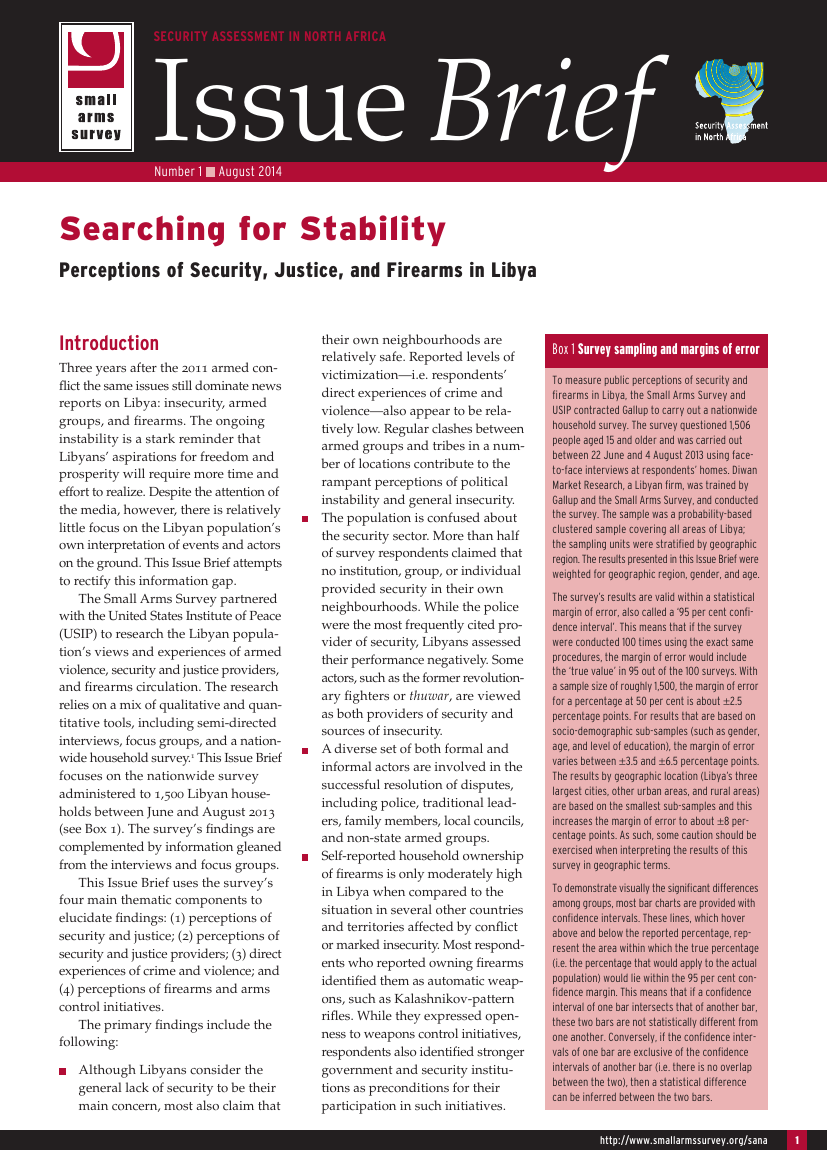
Searching for Stability: Perceptions of Security, Justice, and Firearms in Libya (SANA Issue Brief 1)
Insecurity, armed groups, and firearms are issues that still dominate news reports on Libya today, three years after the armed conflict that swept the country in 2011. The ongoing instability is a stark reminder that Libyans’ aspirations for freedom and prosperity will require more time and effort to realize. Despite the media attention, however, there is comparatively little focus on the Libyan population’s own interpretation of what is happening in their country.
Searching for Stability: Perceptions of Security, Justice, and Firearms in Libya is new Issue Brief from the Small Arms Survey’s Security Assessment in North Africa (SANA) project that attempts to fill this information gap.
The Issue Brief examines the Libyan population’s views and experiences of armed violence, security and justice providers, and firearms circulation. It uses a mix of qualitative and quantitative tools, including semi-directed interviews, focus groups, and a nationwide household survey – administered to 1,500 Libyan households between June and August 2013 – to provide this overview of Libyan perceptions.
Four main thematic components elucidate the Issue Brief’s findings: (1) perceptions of security and justice; (2) perceptions of security and justice providers; (3) direct experiences of crime and violence; and (4) perceptions of firearms and arms control initiatives.
The primary findings include the following:
- Although Libyans consider the general lack of security to be their main concern, most also claim that their own neighbourhoods are relatively safe. Reported levels of victimization—i.e. respondents’ direct experiences of crime and violence—also appear to be relatively low. Regular clashes between armed groups and tribes in a number of locations contribute to the rampant perceptions of political instability and general insecurity.
- The population is confused about the security sector. More than half of survey respondents claimed that no institution, group, or individual provided security in their own neighbourhoods. While the police were the most frequently cited provider of security, Libyans assessed their performance negatively. Some actors, such as the former revolutionary fighters or thuwar, are viewed as both providers of security and sources of insecurity.
- A diverse set of both formal and informal actors are involved in the successful resolution of disputes, including police, traditional leaders, family members, local councils, and non-state armed groups.
- Self-reported household ownership of firearms is only moderately high in Libya when compared to the situation in several other countries and territories affected by conflict or marked insecurity. Most respondents who reported owning firearms identified them as automatic weapons, such as Kalashnikov-pattern rifles. While they expressed openness to weapons control initiatives, respondents also identified stronger government and security institutions as preconditions for their participation in such initiatives.
The Small Arms Survey partnered with the United States Institute of Peace (USIP) to conduct this research. USIP has also published a detailed report — 'Security and Justice in Post-Revolution Libya: Where to Turn?'— mapping the evolution of Libya’s weak security and justice sectors from the Qaddafi era through the revolution to the present day. Drawn from interviews, focus groups, as well as the nationwide household survey, the USIP report analyzes the realities of the security and justice sectors and their impact on ordinary Libyans.
Also available in ARABIC.
- More on the Security in North Africa (SANA) project
Have your say about Small Arms Survey publications and products: take 5 minutes to fill out our questionnaire.